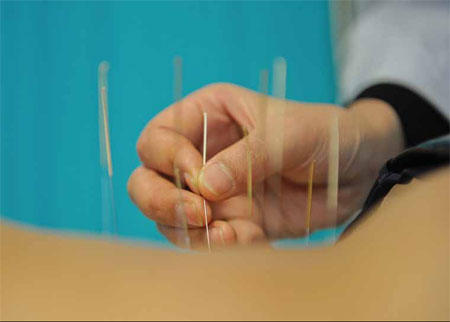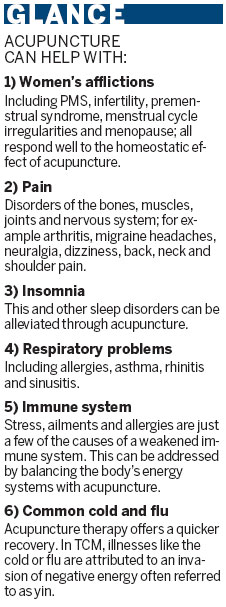Looking sharp
Updated: 2012-06-08 12:40
By Yin Yin (China Daily)
|
|||||||||||
|
Thin, long and sterilized stainless steel needles are inserted into the patient's body in acupuncture therapy to help regulate the body's endocrine system. He Dongping / for China Daily |
Ancient Chinese therapy helps treat disorders such as obesity
Olivia Garcia has tried restricting her diet, exercising and even turning to weight loss drugs, but nothing seemed to shake off those extra kilograms.
"Sticking to a diet is hard for me, I also took many diet pills but those had some side effects. Regular sports are just useless for the lazy," the student from the United States says.
Then one day, a Chinese friend suggested that she try a traditional Chinese medical practice using acupuncture to help treat her obesity.
|
|
"After going through a period of treatment, my huge problem was obviously being alleviated. I lost 10 kg in two months and felt really healthy too," Garcia says.
She is just one of a growing number of foreign and Chinese people suffering from obesity who are swearing by acupuncture as an effective way to treat their ailment.
In this treatment, special thin, long and sterilized stainless steel needles are inserted into the patient's body to help regulate the endocrine system through a relaxing and calming effect.
In line with traditional Chinese medicine (TCM), acupuncture needles are placed on relevant acupoints and kept in position for 30-45 minutes in each session. The method focuses on enhancing metabolism and promoting general well being.
Historical records on acupuncture therapy date back to the Stone Age, when primitive people are said to have used a kind of stone known as bian fashioned into needles to puncture and drain abscesses for treating diseases. The earliest written record of the practice is found in the Yellow Emperor's Inner Canon during the Warring States Period (475-221 BC), with the tract presenting systematically formed theories. Acupuncture established itself as a specialty treatment in the Tang Dynasty (AD 618-907).
During the Song Dynasty (960-1279), the famous physician Wang Weiyi created an illustrated manual for acupuncture and moxibustion, another form of traditional Chinese treatment. Wang's text included the description of 657 acupoints and he made two bronze statues on which the body's meridians and collaterals, energy points central to TCM theory, were engraved as teaching aids. In the Ming Dynasty (1368-1644), needle therapy became a key treatment in TCM.
"Using acupuncture to treat weight loss is becoming one of the latest methods among mainstream TCM practice," says Wang Aicheng, the chief physician of the Beijing University of Chinese Medicine.
TCM physicians say the therapy helps reduce appetite, increase metabolism and improve body-wide circulation. It can also help lower cholesterol levels and overall body weight by mobilizing the patient's "energy stores". Acupuncture can similarly help to reduce anxiety, re-energize the body and control overeating.
"Individuals who are obese or overweight are at greater risk of many health problems such as hypertension, diabetes, fatty liver, dyslipidemia and some cardiovascular diseases. Moreover, pharmacotherapy and liposuction have side effects and may be unsafe for some people. Even diet restriction and regulation of physical activity may sometimes result in unfavorable psychological changes," Wang says.
According to Wang, many acupuncturists treating obesity position needles in the patient's ear. These connect to a relaxation point, along with the lungs, kidneys, liver and nervous system.
A treatment schedule can include a weekly session and continue for 8-12 weeks until the targeted weight reduction is achieved. It contains a combination of auricular and body needle therapy, breathing exercises and abdominal massages, all combined with daily food and lifestyle recommendations. Various acupoints are selected for each method according to the patient's individual symptoms.
TCM physicians target the thyroid, mouth, stomach and spleen as common acupuncture points to help their patients lose weight safely and within a short period of time.
Central to the treatment are the TCM theories of the yin and yang, considered the two opposing forces of the body. The yin represents the cold, feminine and passive parts, while the yang represents the hot, masculine and active ones. TCM practitioners believe that when these two parts are out of balance, the smooth flow of qi energy streams through paths in the body is disrupted. Acupuncture is the art of placing the needles at different points along the meridians and collaterals that link to this flow of qi.
"Meridians and collaterals are said to connect different parts of the body into an organic whole, including the viscera, limbs, five sensory organs and nine orifices," says Joseph Conte de Castelnau, a Frenchman who has studied TCM in China for three years.
TCM practitioners say acupuncture can also control stress and anxiety and keep people relaxed so that the tendency to overeat is reduced. "This traditional Chinese ancient cure, as mono-therapy or complementary therapy, is safe and inexpensive, and is increasingly used in many Western countries," Conte de Castelnau says.
Many patients receiving acupuncture to lose weight say they have reduced craving for carbohydrates and decreased appetite. "Many studies reported in acupuncture today expressed that women with a BMI (body mass index) of more than 28 who used diet, exercise and acupuncture could lose more weight than those who did diet and exercise alone," Castelnau says.
But physicians stress that acupuncture alone will not cause people to lose weight. They will still need to eat healthily and exercise adequately. Still, people who use acupuncture as a support system have shown that it is effective and makes the process easier.
"The acupuncturist can provide help with nutritional counseling and give advice over diet regimens that the patient must maintain for the long term," Conte de Castelnau says. "Using these kinds of programs, the patient can avoid the trap of yo-yo dieting or the tendency to lose weight and then regain it."
The treatment depends on the patient's goals for losing weight, the speed at which they want to lose it, and their commitment to keeping the weight off.
TCM physicians say their acupuncture therapy is safe and painless, especially when it is carried out by a qualified and skilled professional. Some points are not suitable for treatment due to the risk of dizziness or nausea, but the practitioner should be able to assess the suitable parts before proceeding with the treatment.
There is also no need to worry about the use and cleanliness of the needles as most normal hospitals use disposable items that are non-recyclable.
Those suffering from inflamed skin and open wounds should seek adequate medical advice before using the therapy. It might also not be suitable for pregnant women, the elderly or people aged below 21.
yinyin@chinadaily.com.cn
(China Daily 06/08/2012 page26)
Today's Top News
Rescuers race against time for quake victims
Telecom workers restore links
Coal mine blast kills 18 in Jilin
Intl scholarship puts China on the map
More bird flu patients discharged
Gold loses sheen, but still a safe bet
US 'turns blind eye to human rights'
Telecom workers restore links
Hot Topics
Lunar probe , China growth forecasts, Emission rules get tougher, China seen through 'colored lens', International board,
Editor's Picks

|

|

|

|

|

|







